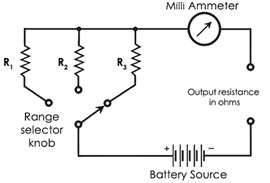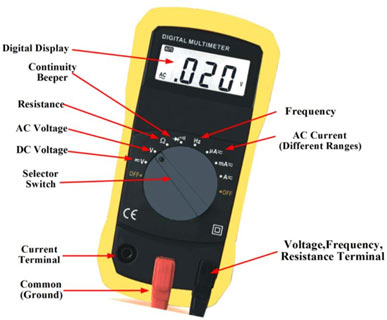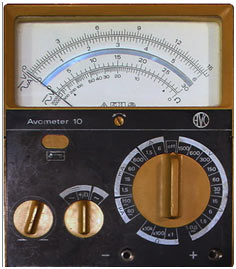Functions of AVO meter:
- It is a very important instrument for measuring volts, ohms, and amperes quickly and easily,
- As well as locating faults in electric or electronic circuits.
Construction and Working
Multimeter basically consists of sensitive moving coil galvanometer which can be converted into
- Multirange ammeter by connecting a current measuring circuit
- Multirange voltmeter by connecting a voltage measuring circuit
- Multirange ohmmeter by connecting a resistance measuring circuit.
Function Switch
A switch called function switch is used. The function switch is the function selector switch that connects the galvanometer with the relevant measuring circuit i.e., current, voltage or resistance.
Voltage Measuring Part
This is multirange voltmeter. This part consists of a number of resistances each of which is connected with the moving coil of the galvanometer in series. It is connected with the help of rang switch.
The value of each resistance depends upon the range voltmeter. The series resistances are called multipliers. It can measure AC voltage but for this purpose, AC is first converted into DC.

Current Measuring Part
It is multirange ammeter. This part consists of the number of low resistances connected with a galvanometer in the parallel circuit. These resistances depend upon the range of the ammeter. This circuit also has a range selection switch SR used to select a particular range.
Resistance Measuring Part
It is multirange ohmmeter. This part consists of a battery of emf Vo and a variable resistance Rs connected with a galvanometer of resistance Rg in series. When the function switch is switched to position X3, the circuit is connected to the X and Y terminals of the AVOmeter.
Before measuring the unknown resistance, it is first zeroed which means that we short circuit the terminals X and Y of the Avometer and adjust Rs to produce full-scale deflection.
Types of Avometer
Based on the working principle, there are two types of AVO meter:
AVO meter analog
AVO Meter utilizing the needle as a tip analog range. To get the measurement results, they ought to be read by range or divisions. The precision of the dimension outcomes of the AVO Meter analog is restricted by the size of the scale pointer, the vibration of the pointer, the accuracy of printing axle, zero calibration, number of ranges of scale. In measurements making use of AVO Meter Analog, dimension errors can take place because of mistakes in monitoring (parallax).
AVO digital meter

Digital multimeter includes an electronic counter and also LCD present instead of relocating needle and ruler. Digital multimeters, which are a little a lot more expensive than analog multimeters, have come to be an extensively made use of multimeter type thanks to their simple reading as well as high accuracy dimension. The important features are:
- More accuracy and precision
- Easy to operate
- Easy to read
- Removes the reading error
- Shows digital values with decimal points, polarity, and units of A, V, and Ω.
Analog multimeters are less costly than their electronic counterparts. Analog multimeters are very delicate because of their interior structure. For this reason, it needs to be transferred meticulously.
MCQs
- 1) What does AVO meter stand for?
- A) Amperage-Voltage-Omicity
- B) Ampere-Volt-Ohm
- C) Analog-Voltage-OHM
- D) Ampere-Voltage-Omega
- Answer: B) Ampere-Volt-Ohm
- 2) Which of the following is NOT a function of an AVO meter?
- A) Measuring electric current
- B) Measuring potential difference
- C) Measuring capacitance
- D) Measuring resistance
- Answer: C) Measuring capacitance
- 3) How is a multimeter constructed to enable its various functions?
- A) It consists of a digital screen only
- B) It utilizes different types of batteries
- C) It includes a sensitive moving coil galvanometer that can be converted into different measuring circuits
- D) It uses a complex network of capacitors and resistors
- Answer: C) It includes a sensitive moving coil galvanometer that can be converted into different measuring circuits
- 4) What is the purpose of the function switch in a multimeter?
- A) To turn the multimeter on and off
- B) To adjust the brightness of the display
- C) To select the range for measuring current, voltage, or resistance
- D) To change the battery
- Answer: C) To select the range for measuring current, voltage, or resistance
- 5) Which part of the multimeter is responsible for measuring voltage?
- A) The current measuring part
- B) The resistance measuring part
- C) The function switch
- D) The voltage measuring part
- Answer: D) The voltage measuring part
- 6) How does the resistance measuring part of a multimeter work?
- A) It measures the resistance directly without any additional components
- B) It uses a battery of emf Vo and a variable resistance Rs connected with a galvanometer in series
- C) It measures the magnetic field strength
- D) It measures the temperature of the circuit
- Answer: B) It uses a battery of emf Vo and a variable resistance Rs connected with a galvanometer in series
- 7) What are the two main types of AVO meters based on their working principle?
- A) Analog and digital
- B) Voltage and current
- C) AC and DC
- D) Ohmic and non-ohmic
- Answer: A) Analog and digital
- 8) What distinguishes a digital multimeter from an analog one?
- A) Analog multimeters are more accurate
- B) Digital multimeters are less expensive
- C) Digital multimeters utilize a digital counter and LCD display
- D) Analog multimeters use decimal points in their readings
- Answer: C) Digital multimeters utilize a digital counter and LCD display
- 9) What is the main advantage of using a digital multimeter?
- A) Higher sensitivity
- B) Lower cost
- C) Simplicity of operation and easy reading
- D) Ability to measure capacitance directly
- Answer: C) Simplicity of operation and easy reading
- 10) Which component is not present in an analog multimeter?
- A) Moving coil galvanometer
- B) Digital display
- C) Range selector switch
- D) Scale pointer
- Answer: B) Digital display
- 11) How does a digital multimeter display measurement values?
- A) Through a moving needle
- B) With a digital counter and LCD display
- C) By adjusting the range selector switch
- D) Using a scale pointer
- Answer: B) With a digital counter and LCD display
- 12) What is the primary drawback of analog multimeters compared to digital ones?
- A) Lack of sensitivity
- B) Inaccuracy due to scale reading errors
- C) Difficulty in operating
- D) Limited range of measurement
- Answer: B) Inaccuracy due to scale reading errors
- 13) Which statement about analog multimeters is true?
- A) They are more expensive than digital multimeters
- B) They are less sensitive due to their internal structure
- C) They are more durable and robust
- D) They provide easy reading and high accuracy
- Answer: B) They are less sensitive due to their internal structure
- 14) How are measurements read in an analog multimeter?
- A) Through a digital counter
- B) By observing the LCD display
- C) By interpreting the position of a moving needle on a scale
- D) By adjusting a range selector switch
- Answer: C) By interpreting the position of a moving needle on a scale
- 15) Which type of multimeter is preferred for its accuracy and precision?
- A) Analog multimeter
- B) Digital multimeter
- C) Ohmmeter
- D) Voltmeter
- Answer: B) Digital multimeter
Summary
Understanding the AVOmeter – Multimeter
Introduction to AVOmeters The AVOmeter, also referred to as a multimeter, serves as a fundamental tool for electrical measurements, encompassing the assessment of current, voltage, and resistance within circuits.
Functional Overview Exploring the multifaceted functions of the AVOmeter, which extend beyond basic measurements to include fault detection in electrical and electronic systems.
Construction and Working Mechanism Delving into the internal structure and operational principles of the AVOmeter, including its utilization of a sensitive moving coil galvanometer adaptable to various measuring circuits.
Function Switch: The Heart of AVOmeter Understanding the pivotal role of the function switch in connecting the galvanometer to specific measuring circuits, enabling seamless transitions between ammeter, voltmeter, and ohmmeter functionalities.
Voltage Measurement Part Detailing the intricacies of the multirange voltmeter setup, which relies on resistances connected in series with the galvanometer to accurately measure voltage across circuits.
Current Measurement Part Exploring the design and functionality of the multirange ammeter, comprising low resistances connected in parallel with the galvanometer to measure current flow within circuits.
Resistance Measurement Part Examining the components and operation of the multirange ohmmeter, featuring a battery, variable resistance, and galvanometer in series for precise resistance measurement.
Types of AVOmeters Distinguishing between analog and digital AVOmeters based on their operational principles, highlighting the unique characteristics and applications of each type.
Analog AVOmeters: Traditional Precision Understanding the functionality and limitations of analog AVOmeters, which utilize needle displays for measurements, requiring careful reading and interpretation.
Digital AVOmeters: Precision in the Digital Age Exploring the advanced features and benefits of digital AVOmeters, which incorporate electronic counters and LCD displays for enhanced accuracy, ease of use, and error-free readings.
Conclusion Summarizing the key components, functionalities, and types of AVOmeters, emphasizing their crucial role in electrical measurements and troubleshooting tasks within diverse circuits and systems.

